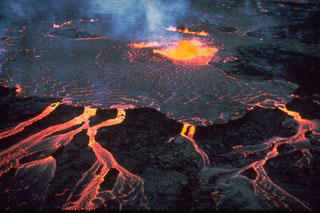Report on Kilauea (United States) — 24 September-30 September 2025
Smithsonian Institution / US Geological Survey
Weekly Volcanic Activity Report, 24 September-30 September 2025
Managing Editor: Sally Sennert.
Please cite this report as:
Global Volcanism Program, 2025. Report on Kilauea (United States) (Sennert, S, ed.). Weekly Volcanic Activity Report, 24 September-30 September 2025. Smithsonian Institution and US Geological Survey.
Kilauea
United States
19.421°N, 155.287°W; summit elev. 1222 m
All times are local (unless otherwise noted)
The Hawaiian Volcano Observatory (HVO) reported that the eruption within Kilauea’s Kaluapele summit caldera, characterized by episodic fountaining, incandescence, and intermittent spatter from craters along the SW margin of Halema’uma’u Crater, continued at variable levels during 23-29 September. Incandescence at both the N and S vents was visible overnight during the week and gas plumes continued to be emitted from them. Scientists did not see lava in the vents during an overflight on 24 September. Weak spattering and occasional flames at the N vent were visible during 27-28 September. Persistent glow from N vent overnight during 28-29 September was punctuated by nine gas-piston cycles of lava overflowing the cone and draining back into the cone. They were recorded at 2147 on 28 September and at 0215, at 0426, at 0512, at 0618, at 0632, at 0700, at 0740, and at 0814 on 29 September, and each lasted 5-10 minutes. There was intermittent but strong incandescence at the S vent. The Volcano Alert Level remained at Watch (the third level on a four-level scale) and the Aviation Color Code remained at Orange (the third color on a four-color scale).
Geological Summary. Kilauea overlaps the E flank of the massive Mauna Loa shield volcano in the island of Hawaii. Eruptions are prominent in Polynesian legends; written documentation since 1820 records frequent summit and flank lava flow eruptions interspersed with periods of long-term lava lake activity at Halemaumau crater in the summit caldera until 1924. The 3 x 5 km caldera was formed in several stages about 1,500 years ago and during the 18th century; eruptions have also originated from the lengthy East and Southwest rift zones, which extend to the ocean in both directions. About 90% of the surface of the basaltic shield volcano is formed of lava flows less than about 1,100 years old; 70% of the surface is younger than 600 years. The long-term eruption from the East rift zone between 1983 and 2018 produced lava flows covering more than 100 km2, destroyed hundreds of houses, and added new coastline.
Source: US Geological Survey Hawaiian Volcano Observatory (HVO)

